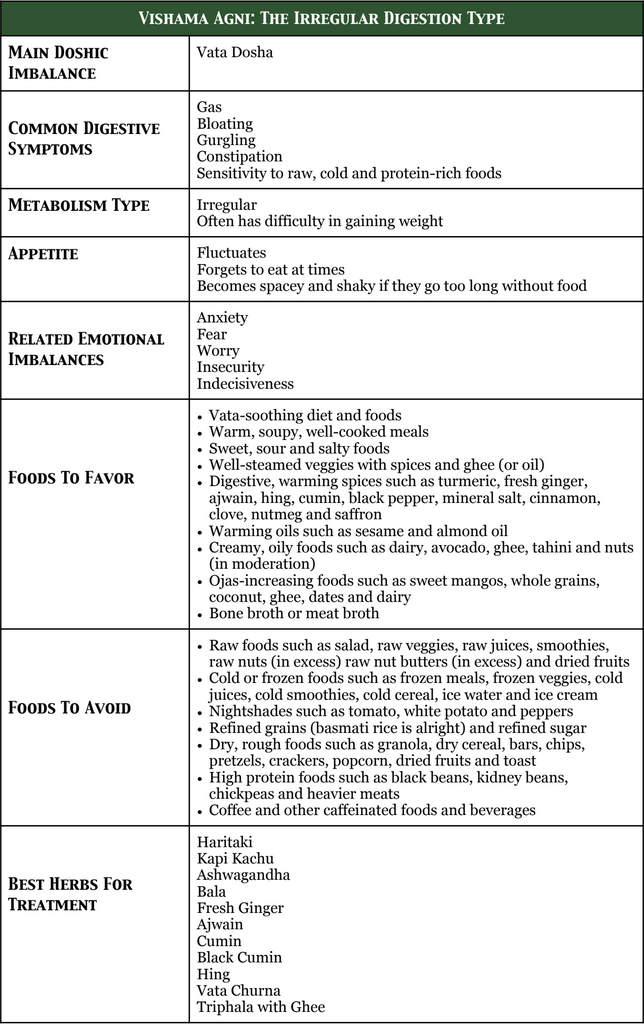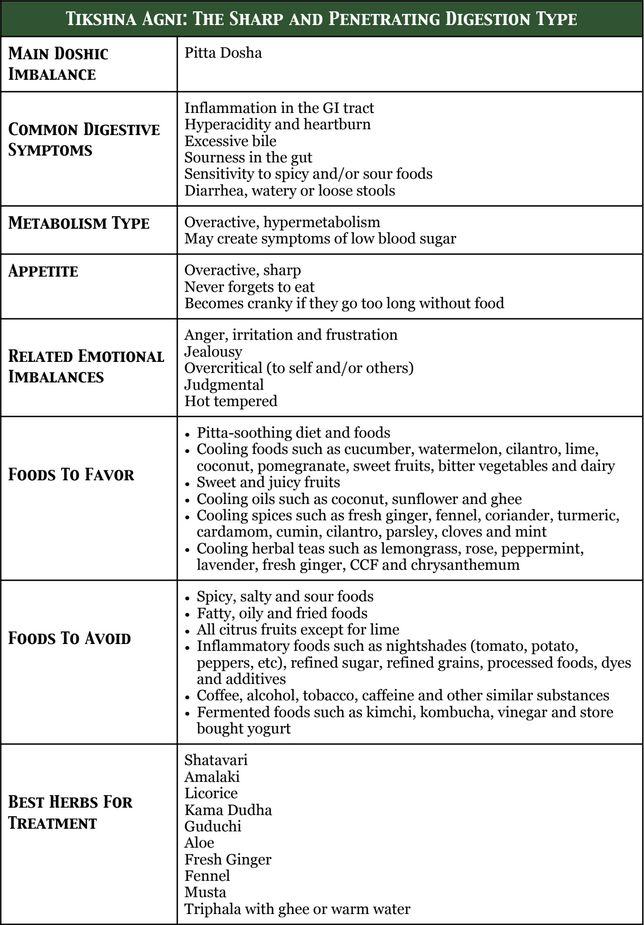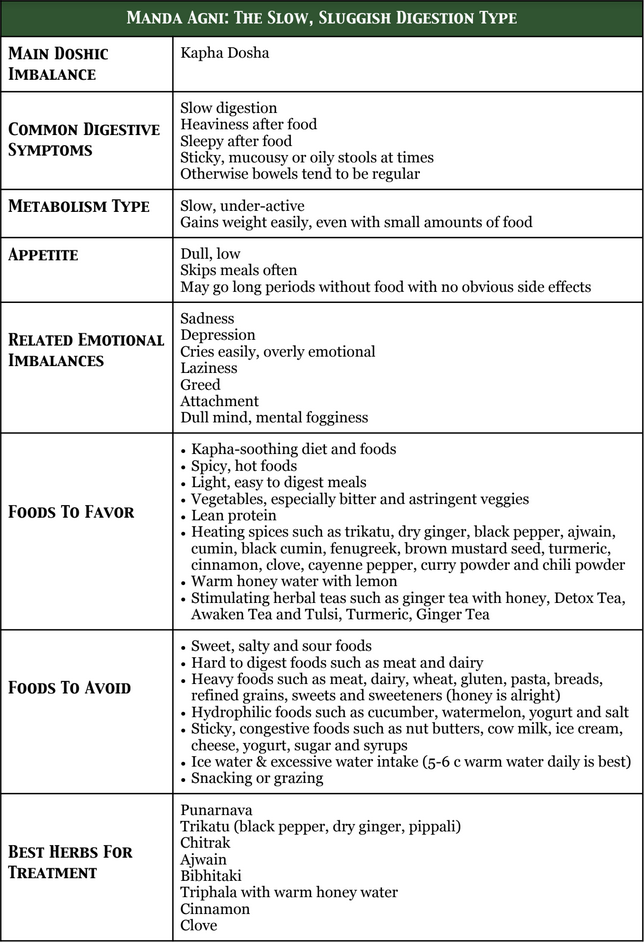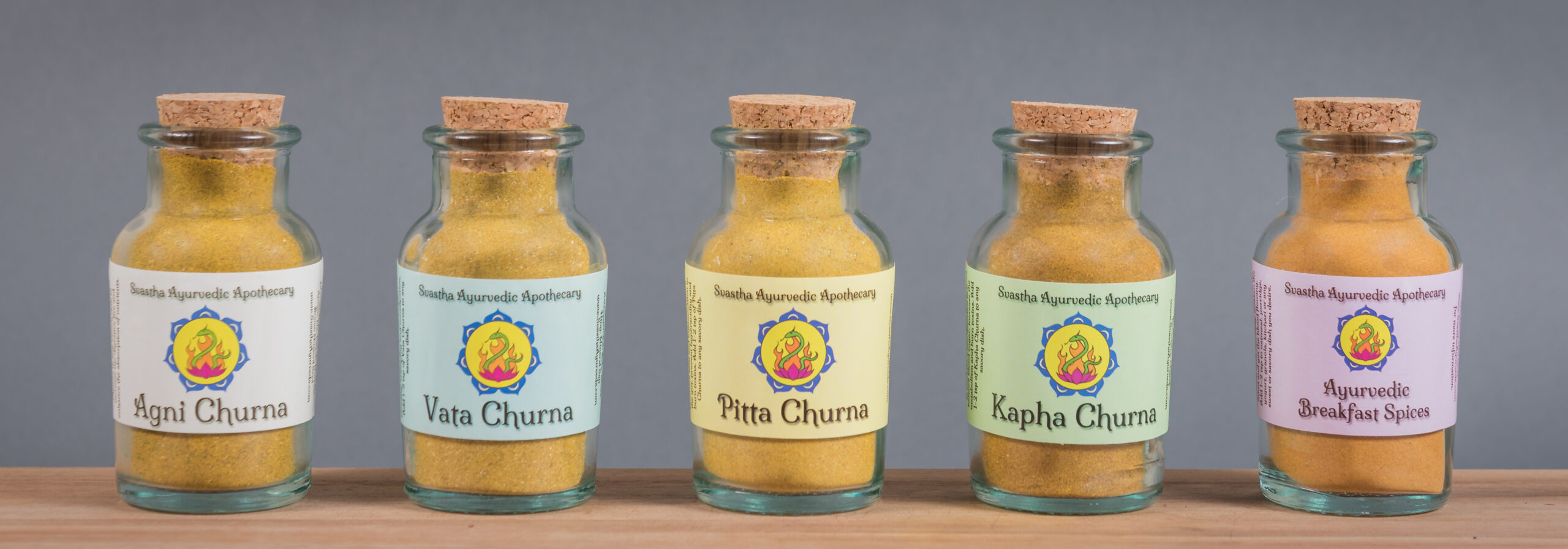 According to Ayurvedic medicine, there are three main types of digestive imbalances, each one relating to a specific doshic imbalance. Since the digestive fire (known as Agni) is the ruler of our overall health, it is vital to know your digestion type in order to utilize the appropriate diet, lifestyle, and herbal regimen for you as an individual. Whether you are looking to treat a disorder or simply maintain a high quality of well-being, working with your digestion type will offer you a clear pathway to optimal health and healing.
According to Ayurvedic medicine, there are three main types of digestive imbalances, each one relating to a specific doshic imbalance. Since the digestive fire (known as Agni) is the ruler of our overall health, it is vital to know your digestion type in order to utilize the appropriate diet, lifestyle, and herbal regimen for you as an individual. Whether you are looking to treat a disorder or simply maintain a high quality of well-being, working with your digestion type will offer you a clear pathway to optimal health and healing.
How we digest our food is directly correlated with our level of health. If an individual is eating a “healthy” diet but is experiencing gas, bloating, and constipation after meals, then that healthy food is likely not healthy for them. When food is not being digested properly (even the healthiest of food types), the nutrients are not being properly assimilated and absorbed, leading to symptoms of indigestion, toxic accumulation, and malabsorption. Unfortunately, this is a common phenomenon among many individuals and has resulted in a large amount of frustration and confusion about what to eat.
Below is a brief introduction to each of the Ayurvedic digestion types. Please note that although there are three types of digestive imbalances, there are actually four digestion types; the fourth one being Sama Agni or “balanced digestion”. Although Sama Agni is a wonderful goal to strive for, it is a fairly rare occurrence to obtain without great care and proper treatment. More than likely, you may fall into one (or more) of the other three digestion types, so please read the charts carefully to discover some basic ideas to bring you and your Agni back to balance!
The Four Digestive Types of Ayurveda
Vishama Agni: The Irregular Fire
The first of the Ayurvedic digestion types is known as Vishama Agni (translated as “irregular fire”) and is related to an imbalance of Vata dosha or the wind element in the body. Like Vata dosha, the symptoms are often fluctuating and irregular. You may experience symptoms such as constipation, gas, bloating, fluctuating appetite, irregular bowel habits, forgetting to eat, spaciness with hunger, anxiety, restless mind, excessive worry, and sporadic mood changes. If there is a coating on the tongue (which shows toxins in the system) it is often brownish in color. Individuals with Vishama Agni often do not digest proteins (e.g. most beans and heavy meats), nor raw foods (e.g. raw vegetables, raw nuts, and green juices) well.
Here is a brief chart that shares some of the general factors for diagnosing and alleviating Vishama Agni.

If you are experiencing Vishama Agni, it will be best to follow a Vata-pacifying diet routine. Warm, well-cooked, mushy meals such as kitchari, dals, basmati rice, quinoa, soups, stews, crock pot meals, and well-steamed veggies will be beneficial while all cold, raw, dry, and rough foods should be avoided.
Taking a digestive aid such as our Vata Honey Infusion and drinking a digestive-enhancing herbal tea such as our CALM Tea is a great way to improve Vata-type digestion issues and aid in absorption. Adding warming digestive spices to your meals such as our Vata Churna will help to reduce symptoms of gas and bloating. Taking Triphala Churna with ghee at bedtime is a great Vata-friendly remedy for promoting a healthy bowel movement each morning.
Click here to read more on a Vata-pacifying diet.
Click here for more tips on how to treat constipation.
Click here for more tips on how to treat gas and bloating.
Tikshna Agni: The Sharp, Penetrating Fire
The second digestion type is related to Pitta dosha or the fire element and it is called Tikshna Agni (translated as “sharp, penetrating fire”). Like Pitta, the symptoms relate to excessive heat in the system and can range from hyperacidity, acid reflux, hyper-metabolism, constant hunger, hypoglycemia (low blood sugar), inflammation in the GI tract, diarrhea, chronic loose stools, cranky hunger (often called “hangry”), anger, criticism, and judgmental tendencies. If a coating is present on the tongue, it often has a yellow, orange, pink, or green hue in color. Individuals with Tikshna Agni often do not digest oily, fatty, fried foods well and cannot tolerate foods with extreme spice (although they tend to love it!).
Here is a brief chart that shares some of the general factors for diagnosing and alleviating Tikshna Agni.

If you are experiencing Tikshna Agni, it will be best to follow a Pitta-pacifying diet routine. Cooling foods should be utilized such as ghee, coconut, dairy, lime, cilantro, cilantro juice, aloe, pomegranate, dates, cucumber, and watermelon while all spicy, sour, and salty foods should be avoided. All inflammatory foods should be removed from the diet as well as most fermented foods, both of which will increase the heat in the system.
Cooling digestive spices such as our Pitta Churna will help to balance the overactive fire and treat symptoms such as hyperacidity, inflammation, and loose stools. Drinking Healthy Digestion Tea or CCF Tea between meals is an effective way to strengthen the digestive fire without creating further heat in the system. If there are signs of leaky gut or general inflammation or heat in the GI tract, you can take 1 teaspoon of Tikta Ghrita each morning on an empty stomach.
Click here to read more on a Pitta-pacifying diet.
Click here for our CCF Tea recipe.
Click here for our Cilantro Juice recipe.
Manda Agni: The Slow, Sluggish Fire
The third digestion type is known as Manda Agni (translated as “slow, sluggish fire”) and is correlated with a Kapha imbalance in the GI tract. Common symptoms of Manda Agni include a dull appetite, sluggish digestion, slow metabolism, heaviness after food, sleepiness after food, excessive weight gain (even with small amounts of food intake), water retention or edema, depression, emotional eating, lethargy, attachment, and intense cravings for sweet or salty foods. Manda Agni almost always correlates with a heavy coating on the tongue and it is often thick and white to off-whitish in color. Individuals with Manda Agni often do not digest heavier food types well such as refined grains (or all grains in some cases), gluten, wheat, meat, eggs, dairy, sweets, and oily foods.
Here is a brief chart that shares some of the general factors for diagnosing and alleviating Manda Agni.

If you are experiencing Manda Agni, it will be best to follow a Kapha-pacifying diet routine. Light, easy-to-digest foods should be favored such as lean protein (fish, chicken, chickpeas, mung beans, red lentils, egg whites), steamed veggies, and light grains (millet, quinoa, buckwheat). It will be extremely important to avoid all heavy, dense food types such as meat (esp. red meat and pork), cow milk, cheese, store-bought yogurt, starches, refined carbs (pasta, bread, white rice), refined sugar, sweets, fatty foods, and salty foods. Snacking should be avoided and all food should be eaten by 6 pm each night.
Taking a digestive strong stimulant before meals such as our Agni Elixir will greatly help to spark digestion and metabolism and reduce the symptoms of heaviness after food. Taking Trikatu Churna in warm water upon awakening is a great way to stimulate digestion and metabolism each morning and ending the day with Triphala Churna in warm honey water will also be of much benefit.
Click here to read more on a Kapha-pacifying diet.
Click here to read more on weight loss with Ayurveda.
Sama Agni: The Balanced Fire
The fourth digestive type is known as Sama Agni (translated as balanced fire) and is a clear sign of total health and optimal well-being. An individual with Sama Agni can eat pretty much any food type without unwanted symptoms of indigestion. Their metabolism is balanced as well as their appetite. After eating a meal, there is energy, vigor, and a sense of lightness. The bowels are very regular with fulfillment after. The stools have the consistency of a ripe banana, no foul smell, and often float in the water. Gas, belching, and bloating are very rare. The tongue is clean of any coating and the breath is fresh (even upon awakening). An individual with Sama Agni, or a balanced digestive fire, will be in a balanced emotional state. Although these individuals are able to eat even the worst of foods without ill effects, they should still maintain a healthy diet according to their body type and current season in order to sustain this well-being that is so hard to obtain.
Here is a brief chart that shares some of the general factors for diagnosing and maintaining Sama Agni.

Although your digestion type may be the same as your personal Ayurvedic body type (i.e. Vata, Pitta, Kapha), it can just as easily be a completely different dosha-related digestive imbalance. For example, a Kapha-predominant individual can often show signs of Vata-type digestion, presenting symptoms of constipation, gas, and bloating. Therefore it is important to analyze the specific digestion symptoms you are currently experiencing in order to properly treat the imbalance.
If you are experiencing symptoms of multiple origins, it will likely be best to go with the one that is presenting with the most symptoms, while keeping in mind your predominant dosha type and the current season. For example, if you are experiencing acid reflux, loose stools, and cranky hunger but also occasional gas and bloating, you should likely go with a Pitta-soothing diet and the other Tikshna Agni recommendations listed above, especially if you are of a Pitta nature and it is in the late spring or summer season. If your varied digestive issues are equal in strength, then it may be best to follow a diet that adheres to both or all three doshas (as the case may be).
Here are some dietary guidelines and food charts that cover multiple doshic needs:
- Vata-Pitta Dietary Guidelines
- Vata-Kapha Dietary Guidelines
- Pitta-Kapha Dietary Guidelines
- Tridoshic Dietary Guidelines
IMPORTANT NOTE: If you are suffering from chronic, severe digestion issues, it is always best to seek personal treatment with a knowledgeable Ayurvedic practitioner for one-on-one care.
Conclusion
Knowing your Ayurvedic digestion type is equally as important as knowing your dosha type when considering the best diet and herbs for your personal needs. Our digestion is the main factor for our overall well-being. It can create disease when imbalanced or bestow us with optimal health, energy, and vitality when it is strong and robust. Whether you are looking to alleviate illness or maintain health, eating for your digestion type will be an essential factor for your success!
Discover our full line of products for digestive support!
Discover some healing recipes with my 30-Minute Ayurvedic Cookbook!*
Discover over 100 herbal remedies in my Ayurvedic Herbal Medicine for Beginners book!*
*All Amazon links are affiliated links, but recommended with care.






One of the best ayurvedic descriptions that I have come across. Thank you very much.
Thank you so much Govind for your kinds words! It means a lot to me to hear this. I am glad you enjoyed the article. Please let me know if you ever have any questions. Thank you for reading!
Namaste,
Danielle
This is wonderful!
Thank you Hari! Please let me know if you have any questions around this information and I will be happy to help.
Many blessings to you:)
Namaste,
Danielle
What is different about white basmati rice vs something like jasmine rice in terms of digestion? I’m a vata type and just bought a huge bag of jasmine rice! Wondering now if I should exchange it for basmati. Thank you.
Hi Susan,
Thank you for your great question! Basmati is said to be longer, drier, less starchy, and less heavy compared with most other types of white rice, including jasmine. If you get authentic and Indian grown Basmati, it tends to cook up so that each grain is separated from each other, rather than clumped together like many other white rices do.
The Jasmine rice is not necessarily bad for your Vata, as long as you can digest it properly. However, Ayurveda does promote Basmati over other types of white rice in terms of a balanced food.
I hope this helps!
Namaste,
Danielle
A really great read, thank you! I always love your articles. I’m dealing with substantial Vata and Pitta digestive imbalance I think pretty equally. Thanks
Hi Govinda,
Thank you for writing in! I am happy you are enjoying the articles and I hope you find the information helpful.
I am not surprised to hear you are experiencing a dual-doshic imbalance in your digestion. Our bodies are very complex so it often hard to put our symptoms in one neat box. I tend toward both Vata and Pitta symptoms when my digestion is out of whack as well. It can be a bit of a balancing act, but after a while it should become more obvious what is helpful and what you need to stay away from. Of course sometimes we need reminders (I just had one myself after adding a bit too much serano pepper to my kitchari – I won’t be doing that again for a while!).
Take good care:)
Namaste,
Danielle
Hi Danielle..
I’m loving reading your website. A recent trip to India and a consultation with an Ayurvedic Doc said that my body nature is VATA KAPHA and my imbalance is Vata Pitta.
My question is. Should I be following a Vata pitta diet? And if so, how do I know if and when things are back in balance?
Looking forward to your reply.. 💖
Hi Sharon,
It is hard to give a definitive answer without seeing you for a consultation, but it sounds like you may do best with a Tridoshic diet. It is generally helpful to eat for your dosha type as well as any doshas that are out of balance, and a Tridoshic diet can be more “foolproof” when you are not working with a practitioner one-on-one.
When you have found balance, you should have a healthy, balanced appetite; regular, healthy elimination; no symptoms of indigestion or toxins; balanced emotions, restful sleep, and feel energetic throughout the day. Needless to say, it is often a work in progress to reach this state, but take it one step at a time:)
Be well!
Namaste,
Danielle